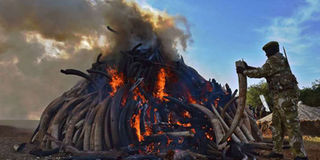Why it makes sense to burn the ivory

A KWS officer throws an ivory tusk onto a burning pile of 15 tonnes of elephant ivory seized in Kenya at Nairobi National Park on March 3, 2015. Burning the ivory stockpiles is part of a wider conservation strategy to eliminate demand for ivory and put value instead on living elephants. AFP PHOTO | CARL DE SOUZA
What you need to know:
- Commentators and experts have been lining up to condemn the planned burning of ivory on Saturday.
- Some of the objections put forward are based on wrong assumptions, some deserve serious consideration.
- Ivory sales are illegal under the terms of the International Convention on the Trade in Endangered Species (CITES) convention, to which Kenya is a signatory.
- Burning the stockpiles is part of a wider conservation strategy to eliminate demand for ivory and put value instead on living elephants.
Commentators and experts have been lining up to condemn the planned burning of ivory on Saturday.
Some of the objections put forward are based on wrong assumptions, some deserve serious consideration.
Here I summarise four of the most frequent arguments being made against the burning and explain why, in my view, they are wrong.
One, for some people, burning ivory makes as much sense as burning bank notes.
Ivory is valuable they say: instead of burning ivory let us sell it and use the proceeds to fund wildlife conservation or support local development initiatives.
Supporters of this viewpoint must recognise that the ivory cannot be sold now even if we wanted to, unless we expect our government to enter the black market.
CITES CONVENTION
Ivory sales are illegal under the terms of the International Convention on the Trade in Endangered Species (CITES) convention, to which Kenya is a signatory.
Okay, the argument goes, but that does not mean we have to destroy it. Maybe the situation will change in the future. Let us keep the stockpiles, as savings for a “rainy day”.
This argument misinterprets the purpose of burning the ivory. It is not really about burning ivory at all: it is about saving elephants.
Burning the stockpiles is part of a wider conservation strategy to eliminate demand for ivory and put value instead on living elephants.
The economic value of elephants is enormous. Leisure tourism generated Sh238 billion for the Kenyan economy in 2014.
More than half-a-million people are employed, directly or indirectly, by the tourism sector.
These benefits are sustainable providing we safeguard our tourism attractions, including elephants and the natural ecosystems they help to maintain.
By contrast the value of all the ivory to be burned next week has been estimated at Sh3 billion, at black market prices.
ECONOMIC SENSE
Two, according to this argument, burning ivory does not make economic sense.
A better alternative would be to release the ivory to the market to drive down the price and put the poachers and traffickers out of business.
These simplistic arguments are dangerous. The relation between supply, price, and demand is more complex than we are sometimes led to believe and is often hard to predict.
But we know that lowering the price of a product will not put anyone out of business if it stimulates demand and increases the volume of sales.
Think of mobile phones. Smart producers realised it was in their interest to reduce prices to tap into the vast potential market in Africa. The potential market for ivory is just as huge.
The only way to save Africa’s elephants is to remove ivory altogether from the market: in other words, we need a political solution and not an economic one.
There are two complementary ways to do this: one is to attach a stigma to buying the product, and the other is to make it illegal.
Three, Some people have questioned whether the ivory will, in fact, burn.
Maybe the whole event is an elaborate piece of theatre to make the ivory “disappear” from the stockpiles and into the hands of corrupt officials and politicians.
It is true that it is hard to make ivory combust: very high temperatures over a prolonged period are needed. But Kenya is an expert in this.
We have the technology and the ivory stockpile will be reduced to a pile of ashes.
CORRUPTION CONCERNS
To allay public concern, KWS should explain in detail how this will be achieved. Aside from the technical issues, underlying this argument are valid concerns about corruption.
This is something that Kenyans are all too familiar with. There are plenty of cases where corrupt police officers and officials have been found to be complicit in ivory trafficking.
But this is an argument in favour of burning the ivory as the only really secure way to keep it out of the hands of corrupt officials.
Four, some commentators have presented the ivory burn as an example of an African country capitulating to pressure from “outsiders”.
According to this narrative, the whole thing is a publicity stunt arranged to please the foreign conservationists who are funding the Giants Club.
Nothing could be farther from the truth. The ivory burn is an authentic Kenyan tradition.
We invented it when in 1989 the first bonfire lit by then president Daniel arap Moi also ignited support for the ban in ivory trade that was approved by CITES later that year.
Kenya is once again showing leadership and raising the bar for other countries.
Dr Kahumbu is the CEO, WildlifeDirect. [email protected].




